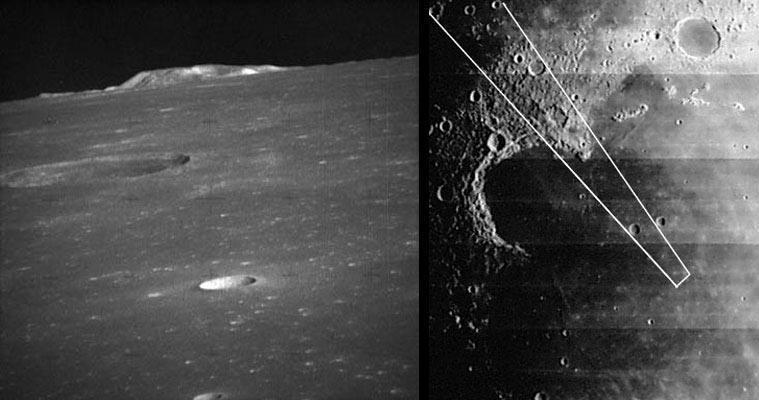Difference between revisions of "November 11, 2004"
| (5 intermediate revisions by the same user not shown) | |||
| Line 1: | Line 1: | ||
__NOTOC__ | __NOTOC__ | ||
=An Oblique View of Prom. Laplace= | =An Oblique View of Prom. Laplace= | ||
| + | <!-- Start of content --> | ||
<table width="85%" border="0" align="center" cellpadding="6" cellspacing="2"> | <table width="85%" border="0" align="center" cellpadding="6" cellspacing="2"> | ||
<tr> | <tr> | ||
| Line 12: | Line 13: | ||
</table> | </table> | ||
<table width="80%" border="0" align="center" cellpadding="8"> | <table width="80%" border="0" align="center" cellpadding="8"> | ||
| − | <tr><td><div align="center" class="main_sm">Image Credit: [http://www.hq.nasa.gov/office/pao/History/ap15fj/a15images.htm Apollo 15 Flight Journal] and AS15-81-10976 and LO IV-i34M</p> | + | <tr><td><div align="center" class="main_sm"><p>Image Credit: [http://www.hq.nasa.gov/office/pao/History/ap15fj/a15images.htm Apollo 15 Flight Journal] and AS15-81-10976 and LO IV-i34M</p> |
</div></td> | </div></td> | ||
</tr> | </tr> | ||
| Line 28: | Line 29: | ||
<br>Rukl <i>Atlas of the Moon,</i> Sheet 10 | <br>Rukl <i>Atlas of the Moon,</i> Sheet 10 | ||
</p> | </p> | ||
| − | <p | + | <p><b>Yesterday's LPOD:</b> [[November 10, 2004|"The First Real Lunar Physical change"]] </p> |
| + | <p><b>Tomorrow's LPOD:</b> [[November 12, 2004|A Giant Messier]] </p> | ||
</tr> | </tr> | ||
</table> | </table> | ||
| Line 39: | Line 41: | ||
<p align="center" class="main_titles"><b>Author & Editor:</b><br> | <p align="center" class="main_titles"><b>Author & Editor:</b><br> | ||
[mailto:tychocrater@yahoo.com Charles A. Wood]</p> | [mailto:tychocrater@yahoo.com Charles A. Wood]</p> | ||
| − | < | + | <!-- Cleanup of credits --> |
| − | + | <!-- Cleanup of credits --> | |
| − | < | + | <!-- Cleanup of credits --> |
| − | + | <!-- Cleanup of credits --> | |
| − | + | <!-- Cleanup of credits --> | |
| − | < | + | <!-- Cleanup of credits --> |
| − | < | + | <!-- Cleanup of credits --> |
| − | + | <!-- Cleanup of credits --> | |
| − | < | + | <!-- Cleanup of credits --> |
| − | + | <!-- Cleanup of credits --> | |
</td></tr> | </td></tr> | ||
</table> | </table> | ||
<p> </p> | <p> </p> | ||
| − | ---- | + | <!-- End of content --> |
| − | + | {{wiki/ArticleFooter}} | |
| − | |||
Latest revision as of 15:03, 15 March 2015
An Oblique View of Prom. Laplace
Image Credit: Apollo 15 Flight Journal and AS15-81-10976 and LO IV-i34M |
|
An Oblique View of Prom. Laplace We see the Moon from such as vast distance that our views mostly have overhead perspectives (except along the limb). Often I have wondered what a particular feature look like on the ground. The Apollo images from the lunar surface provide that view for six spots, but some of the astronauts' low oblique images give a near ground perspective for more areas. And these images are often little known. This is the case for this low perspective looking across northern Mare Imbrium to the edge of the Sinus Iridum crater, which is called Promontory Laplace. This 2.6 km high headland is a fascinating lunar landform that I have observed many times, but until I stumbled across this image in the Apollo 15 Lunar Flight Journal had no idea what it looked like in profile. This view is essentially a cross-section through an impact crater rim. The right side slopes gently (about 8 degrees) down to the surrounding terrain, whereas the inner crater rim (left side) is much steeper - about 25 degrees. The outer rim slope is due to the feathering out of the rim uplift and ejecta, and the steep inner slope results from terrace-forming collapses. In the foreground of the image is the fresh simple crater Helicon B (5.6 km wide, 1.1 km deep) and beyond that is Helicon (25 km, 1.9 km). Technical Details: Related Links: Yesterday's LPOD: "The First Real Lunar Physical change" Tomorrow's LPOD: A Giant Messier |
|
Author & Editor: |
COMMENTS?
Register, Log in, and join in the comments.




